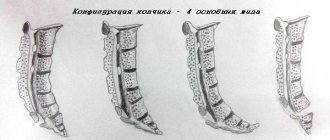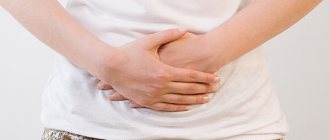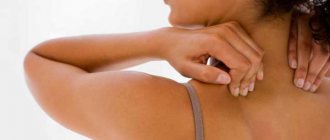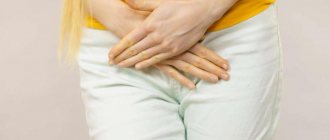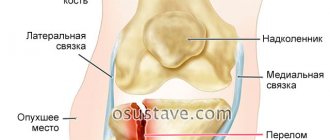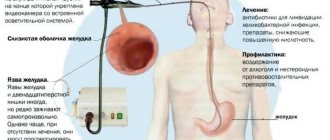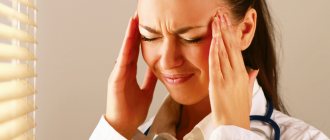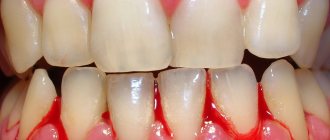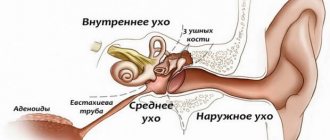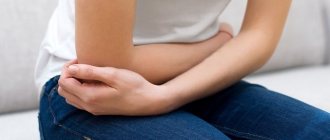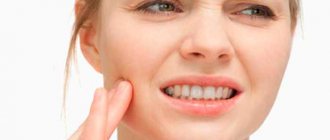Main reasons
The causes of pain are quite varied. Accordingly, treatment tactics may vary in each specific case. What causes sharp shooting pain in the ear?
Ear disease - chronic otitis media
Most often, shooting pain is provoked by bacteria and pathogenic viruses that enter when blowing the nose forcefully. In this case, a disease such as otitis media occurs. It is characterized by the following symptoms:
- sharp pain on one side;
- headache;
- sensation of shooting without pain;
- bloody or purulent discharge;
- hearing loss up to partial loss;
- nausea;
- plugs (laying).
To treat acute otitis, use a cotton swab soaked in boric alcohol (it is placed in the ear canal).
In the case when there is discharge of blood or pus, painless shooting in both ears, the temperature rises, you need to contact an otolaryngologist and be treated with painkillers and antibacterial drugs.
Labyrinthitis
This disease is provoked by viral infections: chickenpox, measles, influenza, mumps.
Labyrinthitis can cause severe complications, so it should be treated by a doctor with proven medical means. Dry heat and compresses help to quickly cure ailments.
Mastoiditis
Mastoiditis is inflammation of the mastoid process. Develops against the background of untreated otitis media.
Mastoiditis can be suspected by an increase in body temperature to 38-40 degrees, loss of appetite, insomnia, headache, throbbing and shooting.
When you press on the mastoid process, a sharp pain occurs, and the skin in this place is red and swollen.
The pathology is dangerous due to complications such as meningitis, labyrinthitis, paralysis of the facial nerve, and suppuration in the neck.
Caries with inflammation of the dental nerve
If an adult or child has ear pain, it may be due to a tooth. When discomfort is caused by inflammation of the dental nerve, a person feels pulsations that intensify when pressed.
This is usually observed with caries of the outer teeth and inflammation of the wisdom teeth. Many people complain: “my ear hurts a lot when I chew.” This has something to do with teeth.
Arthrosis of the jaw joint
This is a pathology of the temporomandibular joint, leading to dystrophic changes in its tissues. Arthrosis of the TMJ is characterized by persistent dull and aching pain in the joint, crunching, clicking, limited mobility, and stiffness. It is difficult for the patient to open his mouth, and when chewing, the pain may radiate to the ears.
On the affected side, the ear sometimes shoots, numbness, tingling of the skin, and headache are felt.
Cellulite and eczema
The auricle can be affected by cellulite. The skin thickens, turns red, there is swelling and pain, and a shooting sensation. The acute form of the disease is called erysipelas. It occurs against the background of erosions, abrasions, and cracks in the shell due to infections getting there.
Eczema is irritation of the skin by allergens or chemicals, also manifested as a result of prolonged leakage of pus. The disease is accompanied by severe itching, redness, swelling of the skin of the ear canal, and the formation of crusts. If you have ear twitching and eczema, you should see a doctor immediately.
Facial neuritis
If there is no otitis, but the ear begins to shoot, it hurts to chew, the face turns red, this may be neuritis of the facial nerve. It can develop due to nervousness or hypothermia.
If you have such symptoms, you need to see a neurologist and undergo treatment. Self-treatment at home is not recommended, and using ear drops without a doctor’s prescription can lead to undesirable effects.
Eustacheite
A common reason for severe ear irritation is eustacheitis. It is a consequence of an untreated runny nose and is manifested by discomfort, hearing loss, and nasal congestion.
Unlike otitis, eustacheitis is an inflammatory disease of the auditory tube. Due to constant swelling in the nasopharynx, the auditory tube takes on part of the load, freeing the nasopharynx and eardrum. This is where lumbago in the ear occurs.
Frontit
Acute inflammation of the frontal paranasal sinus develops against the background of acute respiratory infections or influenza. Frontal sinusitis is severe compared to other forms of sinusitis. Its symptoms include:
- temperature increase;
- swelling of the face;
- severe pain radiating to the head;
- purulent discharge;
- Pain in the eyes;
- change in eyelid color.
With frontal sinusitis, ear pain occurs when the disease becomes severe. Your doctor will tell you how to relieve pain.
Eardrum injury
Damage to the eardrum occurs under the influence of physical, thermal, and chemical factors. As a result of injury, its complete or partial destruction, violation of the integrity of individual layers or elements is observed.
At the time of injury, sharp pain usually occurs. Damage is dangerous due to infection and development of:
- acute otitis media;
- chronic purulent otitis media;
- mastoiditis;
- labyrinthitis;
- otomycosis;
- other pathologies.
Therefore, if the ear constantly shoots and cannot hear, it may be caused by injury.
Exposure to wind
Changeable weather in autumn or spring often leads to colds. Clothes that are not appropriate for the weather and an organism that has not adapted to cold or warm weather can result in shooting pain that radiates to the head.
People in a hurry may run outside immediately after swimming or after diving in a pool. This also leads to undesirable consequences.
Treatment at home can be effective: instillation, heating, use of various drops and folk remedies. But it is important to understand that when the ear aches after a walk, if it shoots, this signals the development of a number of diseases, including those not related to the auditory organs.
Air travel
The unpleasant sensations that arise after a flight are explained by a sharp drop in pressure and, as a result, blockage of the Eustachian tube. This leads to pain and shooting.
What should be done, how to help in this case? To relieve discomfort, it is recommended when flying on an airplane to eat, yawn, swallow saliva more often, and put vasoconstrictor drops into the nose of an adult.
Petrosit
Petrositis is a complication of acute or chronic otitis media, and is caused by infection.
The main symptoms of the disease are a spastic headache on one side. The ear itself shoots a little, but does not hurt. On the affected side, cranial nerve palsy is possible.
Myringitis
Inflammation of the eardrum develops against the background of exposure to mechanical, thermal, and chemical irritants. It can occur with a number of infectious pathologies, for example, measles, influenza, and various septic processes.
Tonsillitis
One of the most common infectious diseases of the upper respiratory tract, characterized by damage to the tonsils and tonsils. It occurs in acute or chronic form. The main symptom of tonsillitis is severe pain in the throat when swallowing, especially in the evening. Discomfort occurs with a runny nose.
The acute form of tonsillitis is popularly called tonsillitis.
Foreign object in the ear
If a foreign object or insect gets in, due to prolonged use of earplugs at night, the skin of the hearing aid becomes inflamed. This manifests itself in swelling, redness of the skin, as well as pain in the shell (periodically shooting in the ear).
When to see a doctor
If your ear hurts and shoots, then this is a reason to immediately visit an ENT doctor . It’s worse when the temperature rises, indicating developing inflammation. Weakness of the facial muscles, swelling of the parotid tissues, throbbing pain are signs of dangerous processes.
With prolonged inflammation, purulent masses break through the eardrum and flow out of the ear canal. If necessary, the abscess can be opened by a doctor. Further treatment is carried out with warming compresses, physiotherapy, disinfection of the ear canal with solutions of Furacilin or Boric acid.
Without treatment, it is possible that complications may develop with complete or partial hearing loss and brain damage. If the unpleasant symptoms suddenly stop, this may be a sign of a ruptured eardrum.
Why does it shoot in the right ear?
The development of symptoms, when the right ear shoots and hurts, is characteristic of purulent inflammation of the skin in the parotid area. It could be:
- suppurating atheroma;
- regional lymphadenitis;
- abscess of the parotid gland.
These pathologies are characterized by unilateral pain, when it shoots only in the right or left ear. In this case, the inflammation site looks swollen and red, there is an increase in temperature, and the person has difficulty hearing.
When the ear shoots, it can mean:
- inflammatory process in the orbit with involvement of nerve structures;
- spread of infection to the organs of hearing and vision after a runny nose and a cold;
- inflammatory processes of the joint-bone apparatus, affecting the right jaw and the back of the head;
- osteocondritis of the spine;
- neuralgia associated with injuries to the right side of the head;
- intervertebral hernia.
Otitis is a disease familiar to many from childhood.
Indeed, most visits to an ENT specialist end with such a diagnosis. Practicing doctors will agree that otitis media is one of the most dangerous diseases. The very first symptoms are discomfort and a feeling that there is a shooting in the ear on the right side. In this case, most often the lesion is unilateral. If it gets started, it can spread to the inner ear and brain, but that's usually how it starts. Why does it usually shoot in the ear on the right side? This is due to the fact that some factors that can contribute to the development of diseases act unilaterally. However, infection during swimming can give a completely different picture.
Why does it jerk on the left?
If older patients complain that the left ear is shooting, this may be due to arthrosis changes in the joints. The disease mainly affects the spine, hip and knee joints. But sometimes the jaw joints are involved in the pathological process, and mainly the left or right side is affected.
In older people, damage to the articular-ligamentous apparatus is a fairly common problem, so it is necessary to undergo an examination, and not think about what to put in or how to help so that the ear does not shoot. The doctor will choose the right treatment tactics.
If you shoot with pain near your ear, you can suspect:
- inflammatory processes of teeth and gums. In this case, the pain intensifies when touching the affected tooth or touching the inflamed gum;
- trigeminal neuralgia. The pain syndrome usually affects one half of the face. The malaise is paroxysmal in nature, reminiscent of lumbago.
Symptoms
As a rule, the pain in this case will be very severe. The minutes drag on like hours. Those who know how it shoots in the ear on the right side understand well what we are talking about. Self-medication in this case can bring temporary relief, but in order to get a proper diagnosis, you need to consult a specialist. An otolaryngologist is competent to treat diseases of the throat, nose and hearing organs. Since they are all closely interconnected, the disease of one organ quickly affects the condition of another.
Get tested
Which doctor should I go to if I experience discomfort? To clarify the diagnosis, it is necessary to consult several specialists (therapist, otolaryngologist, neurologist, surgeon), as well as conduct a number of studies, including:
- otoscopy;
- tympanometry;
- audiometry;
- otoneurological tests;
- tuning fork examination;
- serological and biochemical blood tests to detect infections;
- microscopic examination of a liquid that flows;
- immunological tests;
- bacterial culture of discharge to identify pathogenic microflora and sensitivity to antibiotics.
Only after a thorough diagnosis and determination of the cause of the ailment will the doctor tell you what can be done and how to treat the ear.
Check the outer ear
The test consists of a visual inspection and otoscopy. This is an examination of the ear canal and eardrum using a special tube.
Diagnostics allows us to identify external otitis media or boils in the area of the auricle, which cause a lot of discomfort.
Average
Diagnostics involves examining the degree of mobility of the middle ear and eardrum by giving a sound signal. A microbiological study of the released exudate is also carried out.
The study makes it possible to diagnose chronic otitis media due to a constant runny nose, curvature or rupture of the eardrum, and acute infections.
Internal
The most reliable method for examining the inner ear is computed tomography or CT. With its help, you can see any pathological changes and diagnose otosclerosis, sensorineural hearing loss, labyrinthitis, Meniere's disease, etc.
Drug treatment
Drug therapy is carried out using anti-inflammatory drugs, antibiotics and antiseptics. If the disease is detected at an early stage of development, patients are prescribed ear drops (Miramidez, Normax, Candibiotic, Garazon, Otipax, Sofradex, Otinum). To enhance air exchange in the tympanic cavity, nasal drops with a vasoconstrictor effect (Galazolin, Otrivin, Naphthyzin, Nazol) are used.
See also
How to make a compress from vodka or alcohol and apply it to the ear of a child and an adult, in which cases it is impossible
Read
Anti-inflammatory drugs (Indomethacin, Nimesulide, Diclofenac) help relieve pain and reduce the inflammatory reaction. For moderate and severe forms of the disease, antibiotics are used (Ceftriaxone, Tsifran, Flemoklav Solutab). They are prescribed in the form of drops, tablets and intramuscular injections.
How to treat if your ear hurts and shoots?
Treatment of painful lumbago is carried out using different methods:
- medicinal: antibiotics, ear drops (Otipax, Naphthyzin), boric alcohol are prescribed;
- folk: thermal procedures, alcohol lotions and other time-tested methods;
- physiotherapy: washing and warming;
- bed rest;
- taking vitamins and mineral-vitamin complexes to strengthen the immune system;
- antibiotic therapy when pathogenic microflora is detected.
First aid for adults
Self-treatment of ear diseases is undesirable, since without determining the cause, the situation can worsen.
If you shoot in the ear with pain, first of all:
- Take a pain reliever such as Paracetamol or Ibuprofen. If there is no medicine, smear the ear canal with camphor or castor oil;
- after the discomfort subsides, seek advice from a specialist;
- if the pain is too severe or it is not possible to go to the doctor on your own, you should call an ambulance, which will take the patient to the otolaryngology department;
- In case of mechanical or chemical injuries to the eardrum, it is recommended to immediately place a sterile swab soaked in boric alcohol into the ear canal. You should keep it until the ENT arrives.
How to remove it from a child using folk remedies?
If your child’s ear often shoots, try folk remedies before the doctor arrives. What helps children?
- Take a piece of onion and chop it. Wrap in gauze and place in the ear canal. If the pain does not go away after a while, show your child to a specialist.
- Dissolve half a teaspoon of salt in a glass of water, drop 1 drop into the sore sink.
Under no circumstances should you give your baby alcohol or other substances that can cause skin burns. Without consulting a doctor, do not decide on your own what to drink or what to put in your child’s ear.
Traditional treatment
When the ears shoot, treatment in adults usually involves the following medications:
| Name | How to use |
| Otinum, Otipax | They effectively relieve pain and restore the microflora of the organ. Instill twice a day until complete recovery. |
| Nazol, Naphthyzin, Galazolin | Helps with a runny nose and speeds up the treatment of diseases. Prevents blockage of the Eustachian tube. Place 1 drop in each nasal passage. |
| Amoxicillin, Biseptol | Antibiotics suppress pathogenic microflora and prevent it from spreading. The course of treatment is only as prescribed by a doctor, no less than 7 days and no more than 10 days. |
| Indomethacin, Ortofen, Diclofenac | Anti-inflammatory drugs that help relieve pain. |
| Tavegil, Fenkarol, Suprastin | Decongestants prescribed for signs of allergies. |
What to do at home?
When the ear shoots badly, light therapy is useful. It requires a blue lamp, which helps cope with inflammation and soreness. It is important to know that phototherapy is contraindicated for purulent otitis media.
Another effective way to cure a shooting ear is exposure to ultraviolet light. UV rays do an excellent job of killing bacteria and strengthening the immune system.
Ears that are tingling from a draft can be warmed with warm salt. To do this, you need to heat the salt, wrap it in a stocking and apply it to the sore spot.
Traditional medicine recommends:
- clean the sink with hydrogen peroxide;
- drip a 70% alcohol solution.
This will destroy pathogenic microbes and bacteria and warm the affected area.
If the ear does not shoot too much when yawning or coughing on the left or right side, and there is no temperature, how to warm the painful area? You can smear cotton swabs or disks with campform oil and apply for half an hour.
Prevention
To avoid shooting pain in the ear, the following preventive measures must be observed:
- Swim only in clean reservoirs and pools.
- Protect your ears from water using cotton swabs or a rubber cap.
- Blowing your nose correctly.
- Wear a hat in the cold season.
- Ears should be washed with warm water and soap rather than using cotton swabs.
- Treat diseases of the ENT organs and acute respiratory viral infections in a timely manner.
- If you experience ear discomfort, congestion, itching or pain, consult an ENT doctor as soon as possible.
- Take care and responsibility of your health.
https://youtu.be/RCMEyqeV35g
Preventive actions
Most often it shoots in the ear on the right side when you have a cold. Therefore, with the onset of the cold season, be sure to wear a hat that covers your ears, take vitamins to maintain normal immunity. Do not clean your ears with chopsticks or other foreign objects. It is better to choose peroxide or a 40% alcohol solution. A few drops are placed in the ears, and then wait until all the dirt comes out. You must also take water procedures carefully so that water does not get into the sink. A simple set of procedures allows you to avoid serious problems, so you should not neglect them.
Ischemic attack
If there is a disturbance in the blood circulation of the brain, or a micro-stroke, the patient experiences a shooting pain in the head. Discomfort occurs due to the fact that a blood clot or cholesterol plaque clogs the vascular lumen. A spasm of the vessel occurs, and the required amount of oxygen does not reach the brain cells. In addition to pain, the following symptoms appear: speech impairment, numbness of the fingertips, drowsiness. Vision deteriorates, the patient suffers from nausea and dizziness. A person may forget simple actions and lose coordination.
Diseases of the cervical spine
With osteochondrosis, spondylosis, and other lesions of the cervical spine, patients often complain of a shooting headache behind the ear on one side of the head. Spasmed muscles and overgrown bone processes compress the vertebral artery, disrupting the flow of blood from the carotid artery. In this case, cerebral circulation is disrupted, the patient develops unilateral shooting cranialgia, dizziness, nausea, and loss of coordination.
Caries
The cause of pulsation in the head and shooting pain behind the ear can be caries of molars and wisdom teeth. Shooting appears if you press on a sore tooth, eat, or drink cold or hot liquid. It is enough to cure a bad tooth to get rid of a headache.
An incorrectly formed bite can also provoke headaches with lumbago in the area of the eye, ear, and back of the head. After the pathology is corrected by the orthodontist, the pain disappears.
Migraine
During a migraine attack, the pain does not immediately become shooting. At first, it can gradually spread to one point of the head, involving the frontal lobe and temple. Shooting occurs when moving, when there are sharp sounds, or when there is bright light. Pain can radiate not only to the ear, but also to the temple and eye. Patients complain of a “hot rod poking into the eye or ear.”
Women are most susceptible to migraine attacks. In a migraine state, there is a period of aura - pre-attack. If an aura develops, you can relieve headaches by taking painkillers. It is advisable to adhere to the quiet mode, lie down to rest in a dark, cool room.
Labyrinthitis
The membranous labyrinth is located in the cavity of the inner ear. This department can be affected even before the birth of the child in utero if the mother has suffered infectious diseases such as measles, rubella, and swine flu. The newborn suffers from hearing loss, he experiences tinnitus and dizziness. There are painful shootings in the ear. An abscess appears behind the ear. The child is hospitalized for treatment.
